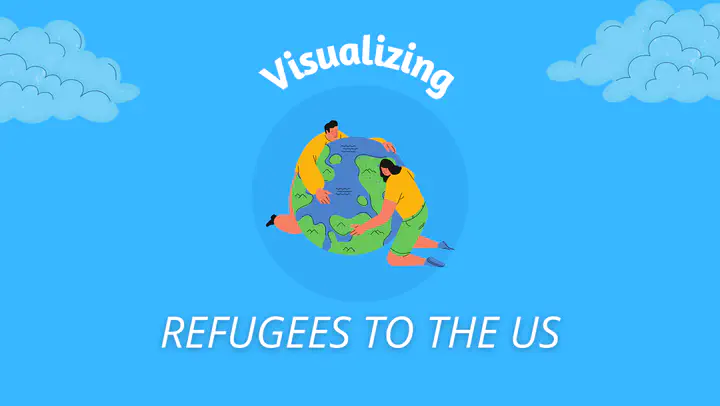Data Visualization Using Bump Charts and Line Plots with `ggplot`

Data Preprocessing
# Create vector of non-countries to filter out
non_countries <- c("Africa", "Asia", "Europe", "North America", "Oceania",
"South America", "Unknown", "Other", "Total")
refugees_clean <- refugees_raw %>%
rename(origin_country = `Continent/Country of Nationality`) %>%
filter(!(origin_country %in% non_countries)) %>%
mutate(iso3 = countrycode(origin_country, "country.name", "iso3c",
custom_match = c("Korea, North" = "PRK"))) %>%
mutate(origin_country = countrycode(iso3, "iso3c", "country.name"),
origin_region = countrycode(iso3, "iso3c", "region"),
origin_continent = countrycode(iso3, "iso3c", "continent")) %>%
gather(year, number, -origin_country, -iso3, -origin_region,
-origin_continent) %>%
mutate(year = as.numeric(year),
year_date = ymd(paste0(year, "-01-01")))
# Dataframe with total sum of refugees by country per year
refugees_countries_cumulative <- refugees_clean %>%
arrange(year_date) %>%
group_by(origin_country) %>%
mutate(cumulative_total = cumsum(number))I pivoted wider to be able to calculate the rankings of each country within the 2006-2015 time period. I then sorted each year to determine the top five ranking score so that I could note the top 5 countries of origin of refugees for each year. I then returned to our tidy dataframe and created a new dataframe with all those countries that ranked in the top 5 over the 2006-2015 time period. And lastly, I saved this newly created dataframe.
top_refugees_all <- refugees_countries_cumulative %>%
filter(year %in% c(2006:2015)) %>%
drop_na(cumulative_total) %>%
group_by(year) %>%
mutate(ranking = rank(cumulative_total)) %>%
ungroup() %>%
pivot_wider(names_from = year, names_prefix = "rank_", values_from = ranking)
top_refugee_countries <- top_refugees_all %>%
select(origin_country, year_date, cumulative_total, rank_2006, rank_2007,
rank_2008,rank_2009, rank_2010, rank_2011, rank_2012, rank_2013,
rank_2014, rank_2015) %>%
filter(rank_2006 >= 49.0 |
rank_2007 >= 42.0 |
rank_2008 >= 38.0 |
rank_2009 >= 37.0 |
rank_2010 >= 35 |
rank_2011 >= 35.0 |
rank_2012 >= 32 |
rank_2013 >= 30 |
rank_2014 >=30 |
rank_2015 >= 28.0)
alltime_refugee <- refugees_countries_cumulative %>%
filter(origin_country %in% c("Cuba","Iran","Russia","Somalia","Vietnam",
"Myanmar (Burma)","Iraq"))
write.csv(alltime_refugee, "alltime_refugees.csv")Import the refined data
Offline, I added the number of refugees granted asylum each year as both a number and proportion to total number of refugees as well as the GDP per capita for each country each year. The number of refugees granted asylym came from the 2015 Yearbook of Immigration Statistics from the Department of Homeland Security. The GDP per capita numbers came from the World Bank’s DataBank.
I then imported that dataframe to work with for the visualizations.
Visualizations of refugee data with a lollipop chart
total <- refugees_countries_cumulative %>%
group_by(year_date) %>%
summarise(total = sum(cumulative_total, na.rm = TRUE))
mypalette <- brewer.pal(10,"Paired")
# Total number of refugees over time
total_plot <- ggplot(total,
aes(x = year_date, y = total)) +
geom_pointrange(aes(ymin = 0, ymax = total),
fatten = 5, size = 1, col = mypalette) +
scale_y_continuous(labels = comma) +
scale_x_date(date_breaks = "1 year", date_labels = "%Y") +
labs(x = NULL, y = NULL,
title = "Total Number of Refugees to the U.S.",
subtitle = "2006-2015",
caption = "Source: Department of Homeland Security") +
bbc_style() +
theme(panel.grid.minor = element_blank(),
plot.title = element_text(face = "bold", size = rel(1.7)),
plot.subtitle = element_text(face = "plain", size = rel(1.3),
color = "grey70"),
plot.caption = element_text(face = "italic", size = rel(0.9),
color = "grey70", hjust = 0),
axis.text = element_text(size = rel(1)),
legend.position = "none")
total plot
complete_refugees$origin_country <- factor(
complete_refugees$origin_country, levels = c(
"Myanmar (Burma)","Iraq","Somalia","Iran","Cuba","Russia","Vietnam"))
total_over_time_plot <- ggplot(complete_refugees,
mapping = aes(year, cumulative_total,
color = origin_country)) +
geom_line(size = 1.1, alpha = .7) +
scale_color_brewer(palette = "Paired") +
scale_x_continuous(breaks = 2006:2015, minor_breaks = 2006:2015) +
scale_y_continuous(labels = comma) +
labs(x = NULL, y = NULL) +
bbc_style() +
theme(panel.grid.minor = element_blank(),
axis.text = element_text(size = rel(.5)),
legend.position = "none")
total over time
rankings_plot <- ggplot(alltime_rank,
aes(x = year, y = rank, color = origin_country)) +
geom_line(alpha = .6, size = 1.5) +
geom_point(size = 1) +
geom_point(alpha = .6, size = 3) +
geom_point(size = 1) +
scale_color_brewer(palette = "Paired") +
scale_y_reverse(breaks = 1:7) +
scale_x_continuous(breaks = 2006:2016, minor_breaks = 2006:2016) +
geom_flag(data = country_flags_start,
aes(x = x, y = y, country = country, size = 1),inherit.aes = FALSE) +
geom_flag(data = country_flags_end,
aes(x = x, y = y, country = country, size = 1),inherit.aes = FALSE) +
theme(legend.position = "none") +
labs(x = NULL,
y = NULL) +
bbc_style() +
theme(panel.grid.minor = element_blank(),
axis.text = element_text(size = rel(.5)),
legend.position = "none")
The Final Product

final product